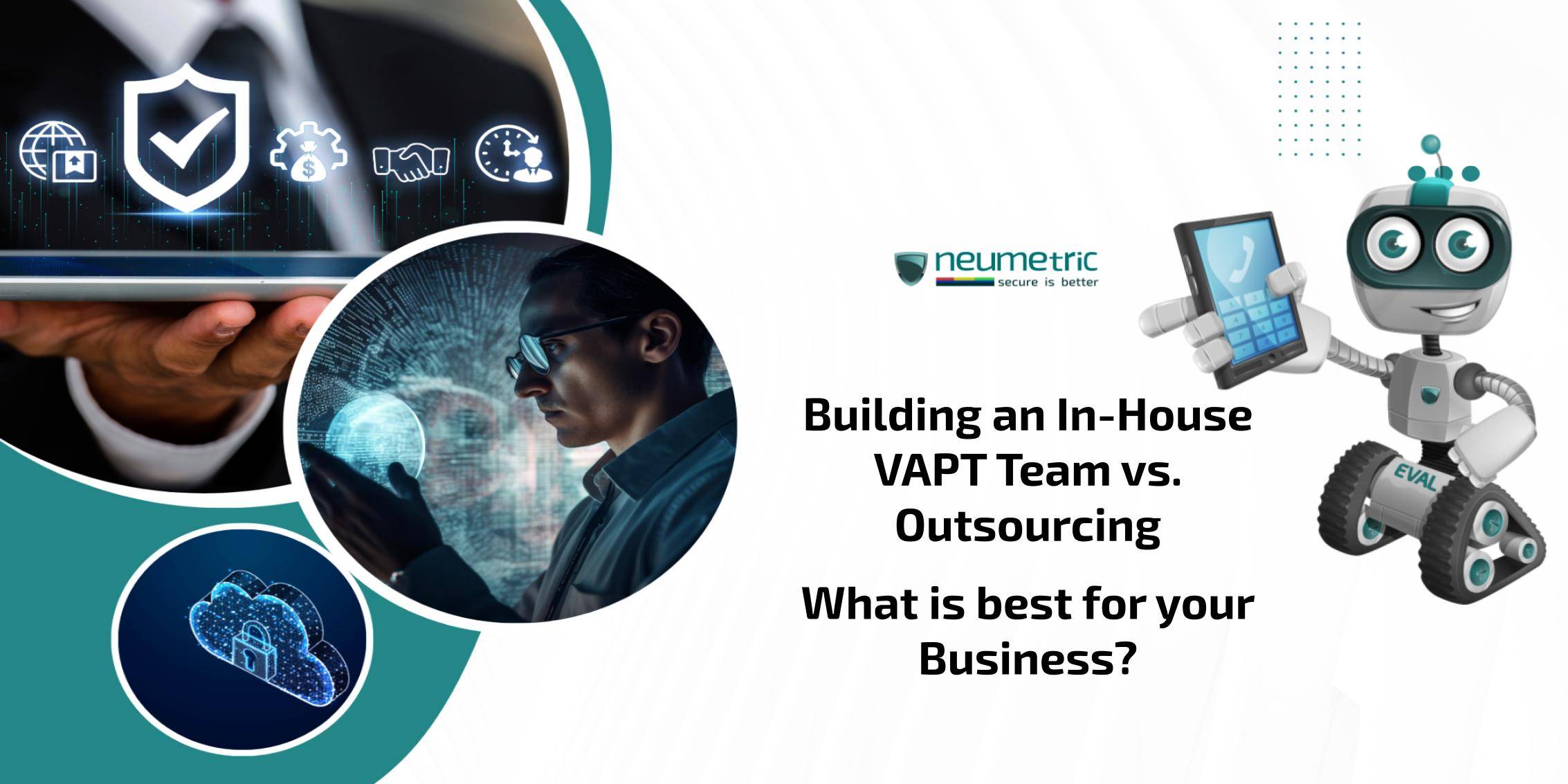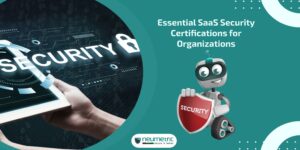Table of Contents
ToggleIntroduction
The importance of cybersecurity cannot be emphasized in today’s fast-paced & linked world, where digital transformation is at the center of business initiatives. Cyber threats are becoming more sophisticated & corporations are continuously looking for methods to strengthen their defenses. Vulnerability Assessment & Penetration Testing [VAPT] are important components of this cybersecurity armory.
VAPT stands for Vulnerability Assessment & Penetration Testing & it is a proactive technique to discover & mitigate potential weaknesses in an organization’s information systems. Vulnerability Assessment entails the systematic scanning & analysis of systems to identify weaknesses, whereas Penetration Testing goes a step further by simulating real-world attacks to assess the effectiveness of existing security measures.
As businesses increasingly rely on digital platforms, the stakes for safeguarding sensitive data have never been higher. The modern business landscape is defined by system interconnection, cloud computing & the proliferation of mobile devices, which makes firms more vulnerable to cyber assaults. A breach jeopardizes not only data integrity but also carries significant financial & reputational concerns.
Organizations must make a vital decision when navigating the complex world of cybersecurity: whether to develop an in-house VAPT team or outsource these services to external professionals. This decision is influenced by a number of factors, including the size of the company, budget limits & the requirement for specialized skills. The discussion revolves around determining the most effective & efficient method of securing systems & safeguarding sensitive information.
Understanding VAPT
VAPT is a proactive & systematic approach to information system security that identifies vulnerabilities & evaluates the possible consequences of exploitation. Its significance stems from the protection of data breaches, financial losses & reputational harm caused by successful cyber assaults.
Key Components of VAPT
Vulnerability Assessment:: The systematic detection & evaluation of vulnerabilities within a system is referred to as vulnerability assessment. This procedure entails scanning networks, systems & apps for potential flaws that malicious actors could exploit.
Penetration Testing: Penetration Testing goes beyond the conclusions of a Vulnerability Assessment by replicating real-world attacks. Ethical hackers, often known as “white hat” hackers, try to exploit reported vulnerabilities in order to evaluate the efficiency of existing security solutions.
The Case for an In-House VAPT Team
As organizations navigate the complex landscape of cybersecurity, the decision to establish an in-house Vulnerability Assessment & Penetration Testing [VAPT] team emerges as a strategic choice. This section explores the advantages & challenges associated with building an in-house VAPT team.
Advantages
Customization & organization Needs Tailoring: In-house VAPT teams are well positioned to design their security methods to the individual needs & complexities of the organization. Knowing the organization’s processes, technology & industry laws intimately allows the team to tailor vulnerability assessments & penetration tests. This focused strategy ensures that security measures are tailored to the specific risk profile of the organization, maximizing their efficacy.
Continuous Monitoring & Quick Response: In-house teams may monitor the organization’s systems, applications & networks continuously. This continuous vigilance allows for the early discovery of developing threats & weaknesses. Rapid response to possible security breaches is critical for mitigating the damage of cyber attacks. In-house teams can quickly deploy mitigation measures, shortening the window of opportunity.
In-Depth Knowledge of Internal Systems: The in-depth knowledge an in-house VAPT team possesses about internal systems is a significant asset. Unlike external vendors who may lack familiarity with the organization’s specific infrastructure, an in-house team has direct access to internal workings. This knowledge facilitates a more comprehensive assessment of vulnerabilities & a nuanced understanding of potential security risks.
Challenges
Resource Intensiveness: Creating & sustaining an in-house VAPT team can be time-consuming & expensive. Financial investments in hiring, educating & retaining competent individuals, as well as obtaining & maintaining specialized tools & technology, are required. The costs of assembling & maintaining a capable in-house team should be carefully weighed against the possible rewards.
Recruitment & skill set challenges: Finding qualified cybersecurity specialists with VAPT expertise can be difficult. The demand for such expertise is considerable & firms compete fiercely for individuals with the necessary talents. Furthermore, the continually evolving nature of cybersecurity necessitates ongoing efforts to attract & retain professionals with current knowledge & skill sets.
Training & Skill Maintenance: Cybersecurity is a dynamic field & skills can quickly become obsolete as new threats & technologies emerge. In-house teams must invest in ongoing training & skill development programs to ensure that team members stay current with the latest trends in cybersecurity. This requires a commitment to continuous learning & professional development.
Outsourcing VAPT Services
Outsourcing Vulnerability Assessment & Penetration Testing [VAPT] services is a strategic choice that offers unique advantages & comes with its own set of challenges. Let’s explore the benefits & challenges associated with outsourcing these critical cybersecurity functions.
Advantages
Cost-Effectiveness: Many firms might save money by outsourcing VAPT services. External vendors frequently operate on a scalable approach, allowing firms to have access to top-tier cybersecurity knowledge without making large upfront investments in personnel, training & technology. Outsourcing often has a more flexible cost structure because firms pay for services performed rather than keeping a fixed in-house crew.
Access to Specialized Expertise: External VAPT providers are frequently made up of specialized teams with a wide range of abilities & experience. Organizations can tap into a pool of cybersecurity professionals who are experts in their respective fields by outsourcing. This knowledge is especially useful when working with sophisticated or specialty areas of cybersecurity, ensuring that the business has access to the most recent industry knowledge & cutting-edge tools.
Scalability & flexibility: Outsourcing allows enterprises to scale VAPT services based on current demands. This scalability is especially beneficial for firms with changing workloads or those experiencing quick growth. External vendors can quickly respond to changes in demand, offering the required resources & experience without the limits of a set in-house staff.
Challenges
Lack of Immediate Response: One of the challenges of outsourcing VAPT services is the possibility of a delayed response. External vendors may work on several projects & have multiple clients, thus response times may vary. Waiting for a third-party provider to mobilize resources & resolve a critical vulnerability may cause delays in an emergency situation. When considering outsourcing, businesses must carefully examine the urgency of their cybersecurity requirements.
Limited Understanding of Specific Business Context: External VAPT suppliers may lack an intimate understanding of the organization’s specific business context, processes & internal systems. This can lead to more general evaluations that do not completely represent the complexities of the organization’s risk picture. Effective coordination & communication are critical for bridging this gap & ensuring that the outsourced team fulfills the organization’s particular security requirements completely.
Concerns about data security: Entrusting sensitive data & systems to an external party poses data security concerns. To maintain the confidentiality, integrity & availability of their data, organizations must properly vet & trust their chosen VAPT service provider. Compliance with data protection regulations & industry standards is essential to mitigate the risk of data breaches or unauthorized access during the outsourcing process.
Making the Decision
A. Evaluating Business Needs & Objectives
Identifying key Assets & Data: The first stage in the decision-making process is to conduct a thorough examination of the organization’s key assets & sensitive data. Understanding what needs to be protected is critical for developing a VAPT plan. Internal teams may have an advantage in this aspect because they are familiar with the organization’s infrastructure & data flow.
Budget Constraints: Budget concerns are critical in the decision-making process. Fixed expenses related with recruitment, training & infrastructure are linked with in-house teams, whereas outsourcing gives a more flexible cost structure. Budget limits must be carefully balanced against the required level of cybersecurity & the specific needs of the organization.
B. Risk Assessment
Analyzing Potential Threats & Vulnerabilities: Conducting a thorough risk assessment involves identifying potential threats & vulnerabilities that could compromise the organization’s security. In-house teams, with their in-depth knowledge of internal systems, can provide a nuanced understanding of specific risks. External vendors, however, may bring a broader perspective, leveraging experience across diverse industries.
Considering Compliance & Regulatory Requirements: Compliance with industry rules & data protection laws is an absolute must. Companies must decide if an in-house staff or an outside source is better able to navigate & assure compliance. External vendors frequently specialize in keeping up with changing rules, giving crucial expertise in this critical area.
C. Creating a Decision Matrix
Weighing Pros & Cons: A decision matrix can be a valuable tool for systematically weighing the pros & cons of each option. Factors such as customization, cost, response time & data security can be assigned weights based on their importance to the organization. This systematic approach helps in objectively evaluating the trade-offs between in-house & outsourced VAPT services.
Aligning with Long-Term Business Goals: The decision-making process should align with the organization’s long-term business goals. Considerations such as scalability, adaptability to evolving threats & the ability to meet future cybersecurity needs should be integral to the decision. Both in-house & outsourced models should be evaluated for their alignment with the organization’s strategic trajectory.
Best Practices for VAPT Implementation
Regardless of Approach: Certain best practices apply regardless of whether a firm chooses an in-house staff or outsources. Fostering a culture of cybersecurity awareness, regular employee training & implementing comprehensive security rules & practices across the firm are examples of these.
Maintaining Regular Audits & Updates: An effective VAPT approach requires regular audits & updates. Periodic evaluations should be conducted by internal & external teams to detect & resolve new vulnerabilities. This continuous procedure ensures that the organization’s security measures remain robust in the face of evolving cyber threats.
Working with the Internal IT & Security Teams: Collaboration is essential for success between VAPT teams & internal IT & security departments. In-house teams should connect seamlessly with current departments, exchanging insights & collaborating to fix problems. Effective communication channels must be developed for outsourced services to guarantee a cohesive & integrated strategy to cybersecurity.
The Future of VAPT in Business Security
Emerging Trends & Technologies
AI & Machine Learning: Incorporating Artificial Intelligence [AI] & Machine Learning [ML] into VAPT procedures improves the ability to detect & respond to threats in real time. More efficiently than traditional approaches, automated technologies can analyze large datasets, find trends & predict potential weaknesses.
Cloud Security: As more enterprises migrate to cloud environments, VAPT policies will need to evolve to address the particular issues that cloud security presents. This includes cloud-based application, data & infrastructure security.
IoT Security: As Internet of Things [IoT] devices proliferate, new entry points for cyber threats emerge. To assess & safeguard networked devices & prevent potential vulnerabilities in the IoT environment, VAPT solutions will need to improve.
Adapting to Evolving Threat Landscapes
Integration of Threat Intelligence: It is critical to stay up to date on the latest threat intelligence. To keep ahead of developing threats & vulnerabilities, VAPT teams, whether internal or external, must incorporate threat intelligence inputs.
Zero-Day Vulnerability Detection: Zero-day vulnerabilities represent a major risk because they are unknown to vendors & hence lack existing patches. To reduce the window of exploitation, future VAPT strategies must focus on early detection & mitigation of zero-day vulnerabilities.
Continuous Monitoring: By shifting to continuous monitoring, organizations can notice & respond to hazards in real time. A proactive approach to cybersecurity is provided by continuous monitoring in conjunction with frequent VAPT examinations.
Conclusion
The decision in cybersecurity between developing an in-house Vulnerability Assessment & Penetration Testing [VAPT] team versus outsourcing services is complex. Identifying vital assets, considering financial restrictions, doing a thorough risk assessment & developing a decision matrix are all important factors. These variables must be carefully considered in order to fit the chosen technique with the organization’s specific demands & long-term goals.
A comprehensive strategy to cybersecurity is essential, transcending the choice between in-house & outsourced VAPT. Cybersecurity should be viewed as an integral component of an organization’s entire strategy. This includes instilling a cybersecurity culture throughout the firm, creating comprehensive security policies & prioritizing frequent training. Businesses may strengthen their defenses against cyber attacks & build a resilient security infrastructure by adopting a holistic attitude.
Developing a robust VAPT strategy necessitates an adaptive attitude & a dedication to ongoing improvement. Organizations must remain watchful as technology changes & attacks become more sophisticated. Incorporating rising trends & technologies like AI & machine learning, while adjusting to cloud security & the Internet of Things [IoT] problems, positions firms for future success. The dynamic equation of in-house versus outsourced skills emphasizes the need for both internal expertise & external specialty.
FAQ’s
- What is VAPT & why is it important?
VAPT stands for Vulnerability Assessment & Penetration Testing. It is essential for identifying & addressing security vulnerabilities in computer systems, applications & networks to prevent unauthorized access & data breaches.
- What challenges come with an in-house VAPT team?
Challenges include resource intensiveness, recruitment & skill set challenges & the ongoing need for training & skill maintenance, which may strain budgets & resources.
- What challenges can be associated with outsourcing VAPT services?
Challenges include potential delays in response time, limited understanding of specific business contexts & concerns about data security when entrusting sensitive information to external providers.





